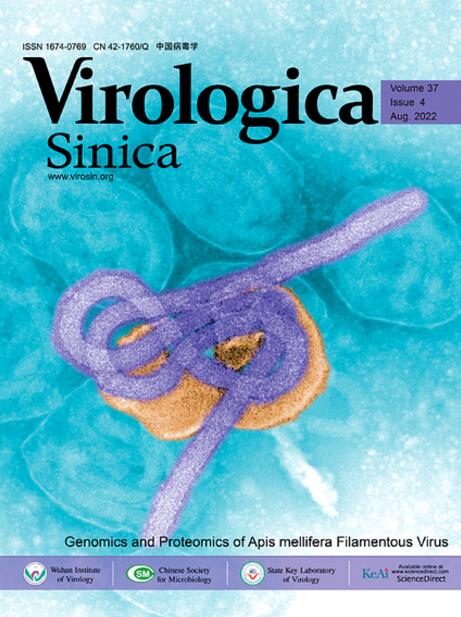Construction and validation of a mouse model for studying severe human adenovirus infections
IF 4
3区 医学
Q1 Medicine
引用次数: 0
Abstract
Human adenoviruses (HAdVs) are highly contagious pathogens with various genotypes implicated in acute respiratory disease (ARD) and linked to fatality, especially in immunosuppressed patients, young children, and military recruits. Currently, no vaccines or specific drugs are approved for clinical use. The hosts of adenoviruses are strictly species-specific, which strongly limits the development of vaccines and drugs against HAdVs. In this study, immunocompetent BALB/c mice were challenged with different doses of human adenovirus type 5 (HAdV-5) via tail intravenous injection (i.v.). All mice challenged with a high dose of HAdV-5 (3.2 × 1010 TCID50/kg) died within 3–5 days, while those receiving a low dose of HAdV-5 (8 × 109 or 4 × 109 TCID50/kg) survived. Interestingly, among the mice receiving a medium dose of HAdV-5 (1.6 × 1010 TCID50/kg), 60% (n = 3/5) of male mice died, while all female mice survived. This suggests that male mice may be more susceptible to HAdV-5 infection than female mice, consistent with clinical findings in children. HAdV-5 DNA was mainly distributed in the liver, followed by the spleen and lung. Pathological changes were observed in the lung, liver, and spleen, with severity increasing in correlation with the virus challenge dosage. Transcriptome and qPCR analyses of the liver indicated that the down-regulated expression of the H2-Aa, H2-Ea-ps, CD74, and H2-Eb1 genes in male mice, as well as the AHR gene in female mice, may contribute to the observed higher mortality rates in male mice. Therefore, this effective, feasible, and cost-efficient mouse model could serve as a candidate for evaluating HAdV vaccines and anti-adenovirus therapeutics.
构建并验证用于研究严重人类腺病毒感染的小鼠模型。
人类腺病毒(HAdVs)是具有高度传染性的病原体,其各种基因型都与急性呼吸道疾病(ARD)有关,并与死亡率相关,尤其是在免疫抑制患者、幼儿和新兵中。目前,还没有疫苗或特效药物被批准用于临床。腺病毒的宿主具有严格的物种特异性,这极大地限制了针对 HAdV 的疫苗和药物的开发。在这项研究中,免疫功能正常的 BALB/c 小鼠通过尾部静脉注射(i.v.)不同剂量的人腺病毒 5 型(HAdV-5)。所有接受高剂量HAdV-5(3.2×1010 TCID50/kg)挑战的小鼠均在3至5天内死亡,而接受低剂量HAdV-5(8×109或4×109 TCID50/kg)挑战的小鼠则存活下来。有趣的是,在接受中等剂量 HAdV-5(1.6×1010 TCID50/kg)的小鼠中,60%(n = 3/5)的雄性小鼠死亡,而所有雌性小鼠都存活下来。这表明雄性小鼠可能比雌性小鼠更容易感染HAdV-5,这与儿童的临床发现一致。HAdV-5 DNA主要分布在肝脏,其次是脾脏和肺部。肺、肝脏和脾脏都出现了病理变化,其严重程度随病毒挑战剂量的增加而增加。肝脏转录组和 qPCR 分析表明,雄性小鼠的 H2-Aa、H2-Ea-ps、CD74 和 H2-Eb1 基因以及雌性小鼠的 AHR 基因表达下调,这可能是雄性小鼠死亡率较高的原因。因此,这种有效、可行且成本效益高的小鼠模型可作为评估 HAdV 疫苗和抗腺病毒疗法的候选模型。
本文章由计算机程序翻译,如有差异,请以英文原文为准。
求助全文
约1分钟内获得全文
求助全文
来源期刊

Virologica Sinica
Biochemistry, Genetics and Molecular Biology-Molecular Medicine
CiteScore
7.70
自引率
1.80%
发文量
3149
期刊介绍:
Virologica Sinica is an international journal which aims at presenting the cutting-edge research on viruses all over the world. The journal publishes peer-reviewed original research articles, reviews, and letters to the editor, to encompass the latest developments in all branches of virology, including research on animal, plant and microbe viruses. The journal welcomes articles on virus discovery and characterization, viral epidemiology, viral pathogenesis, virus-host interaction, vaccine development, antiviral agents and therapies, and virus related bio-techniques. Virologica Sinica, the official journal of Chinese Society for Microbiology, will serve as a platform for the communication and exchange of academic information and ideas in an international context.
Electronic ISSN: 1995-820X; Print ISSN: 1674-0769
 求助内容:
求助内容: 应助结果提醒方式:
应助结果提醒方式:


